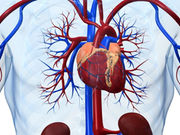Studies show link for patients with acute myocarditis with preserved LVEF, suspected myocarditis
FRIDAY, Oct. 13, 2017 (HealthDay News) — For patients with acute myocarditis (AM) with preserved left ventricular ejection fraction (LVEF) and for patients with suspected myocarditis, late gadolinium enhancement (LGE) on cardiac magnetic resonance imaging (CMR) is associated with worse prognosis, according to two studies published online Oct. 9 in the Journal of the American College of Cardiology.
Giovanni Donato Aquaro, M.D., from the Gabriele Monasterio Foundation in Italy, and colleagues assessed CMR results from 374 patients with AM and preserved LVEF. The researchers found that 41 percent of patients had LGE that involved the subepicardial layer inferior and lateral wall, 36 percent had LGE that involved the midwall layer of the anteroseptal wall (AS group), and 16 percent had LGE in other segments; 26 patients had no LGE. Compared with other groups, the AS group had a greater extent of LGE and higher LV end-diastolic volume index but lower levels of inflammatory markers. The AS group had worse prognosis than other groups. AS LGE was the best independent CMR predictor of the combined end point of cardiac death, appropriate implantable cardioverter-defibrillator firing, resuscitated cardiac arrest, and hospitalization for heart failure (odds ratio, 2.73).
Christoph Gräni, M.D., from Harvard Medical School in Boston, and colleagues followed 670 patients with suspected myocarditis who underwent CMR. The researchers found that 98 patients experienced a major adverse cardiovascular event (MACE) at a median follow-up of 4.7 years. Overall, 44 percent of patients showed LGE presence, which correlated with increased risk of MACE (hazard ratio, 2.22). LGE presence maintained a significant correlation with MACE in the multivariable model (hazard ratio, 1.72).
“CMR tissue characterization provides effective risk stratification in patients with suspected myocarditis,” Gräni and colleagues write.
One author from the Aquaro study and two authors from the Gräni study disclosed financial ties to the pharmaceutical or medical device industry.
Abstract — Aquaro
Full Text (subscription or payment may be required)
Abstract — Gräni
Full Text (subscription or payment may be required)
Editorial (subscription or payment may be required)
Copyright © 2017 HealthDay. All rights reserved.








